Morphology and molecular phylogeny of three black corals(Antipatharia,Schizopathidae) from seamounts in the Western Pacific Ocean,with description of a new species*
Ting LÜ ,Zifeng ZHAN ,Kuidong XU
1 Laboratory of Marine Organism Taxonomy and Phylogeny, Shandong Province Key Laboratory of Experimental Marine Biology, Institute of Oceanology, Center for Ocean Mega-Science, Chinese Academy of Sciences, Qingdao 266071, China
2 Laboratory for Marine Biology and Biotechnology, Pilot National Laboratory for Marine Science and Technology (Qingdao),Qingdao 266237, China
3 University of Chinese Academy of Sciences, Beijing 100049, China
Abstract Three deep-sea black corals belonging to the family Schizopathidae,are reported from two seamounts on the Caroline Ridge in the tropical Western Pacific:Umbellapathes parva sp.nov.with depth of 1 488–1 766 m,Telopathes cf.magna MacIsaac &Best,2013 with depth of 937–1 016 m,and Stauropathes cf.punctata (Roule,1905) with depth of 942–1 353 m.The latter two species are the first records in the Western Pacific Ocean.U.parva sp.nov.is characterized by monopodial corallum,relatively long unpinnulated stalk with complex pinnulated branches developing from the lowermost primary pinnules and small spines.It differs from two known congeners by much smaller spines and the present of secondary pinnules.T.cf.magna MacIsaac &Best,2013 has sparsely branched corallum,relatively long and simple pinnules arranged in subopposite or alternate pairs.S.cf.punctata (Roule,1905) is characterized by the corallum with almost planar pinnulated branches,and pinnules arranged in subopposite pairs.Our results indicate that the corallum size and shape are variable in conspecific specimens particularly those at different growth stages.By contrast,the size of the polypar spines as well as the abpolypar spines have little variation and can be served as a main differing feature for schizopathid species.The phylogenetic analyses using nuclear internal transcribed spacer region (spanning partial 18S rDNA,ITS1,5.8S,ITS2,and partial 28S rDNA) and two mitochondrial fragments cox3-IGR-cox1 (COI) and trnW-IGR-nad2 (NAD2) showed Telopathes,Stauropathes,and Bathypathes had close relationships,and Umbellapathes formed a sister clade with Alternatipathes.
Keyword:Anthozoa;black coral;new species;seamount;taxonomy;Western Pacific
1 INTRODUCTION
Members of the black coral order Antipatharia are widely distributed in oceans,ranging from shallow waters to deep seas,and more than 75% species occur in depths over 50 m (Cairns,2007;Wagner et al.,2012).This order belongs to the anthozoan subclass Hexacorallia and encompasses 7 families,46 genera,and 273 species (Opresko et al.,2020;Terrana et al.,2020).Within Antipatharia,members of the family Schizopathidae are mainly distributed in deep seas(Molodtsova and Opresko,2017).The family consists of two subfamilies and 13 genera,with varying degrees of pinnulation (Opresko,2002,2005;MacIsaac et al.,2013;Molodtsova and Opresko,2017).
To explore the biodiversity on seamounts in the tropical Western Pacific Ocean,we conducted a cruise in the region the Caroline Ridge in May 2019.By using the remotely operating vehicle (ROV),we obtained ten black coral specimens of the family Schizopathidae.Based on the morphological analyses,three specimens are identified asUmbellapathesparvasp.nov.,four specimens areTelopathescf.magna,and three specimens areStauropathescf.punctata.Meanwhile,their genetic distances and phylogenetic positions are evaluated using the region of the nuclear internal transcribed spacer (ITS1 and ITS2) and two mitochondrial fragmentscox3-IGRcox1(COI) andtrnW-IGR-nad2(NAD2).
2 MATERIAL AND METHOD
2.1 Specimen collection and morphological examination
During the 2019 R/VKexue(Sciencein Chinese)cruise,samples from two seamounts (tentatively named as Caroline Seamounts M5 and M8) on the Caroline Ridge in the tropical Western Pacific were obtained by the ROVFaxian(Discoveryin Chinese)(Fig.1).Before sampling,the specimens were photographed in situ.After collection,samples were photographed on the deck.The collected specimens were stored in 85% ethanol,and some branches of each specimen were stored at -80 °C for molecular research.All the sampled specimens were deposited in the Marine Biological Museum of Chinese Academy of Sciences (MBMCAS) at Institute of Oceanology,Chinese Academy of Sciences (IOCAS),Qingdao,China (Table 1).
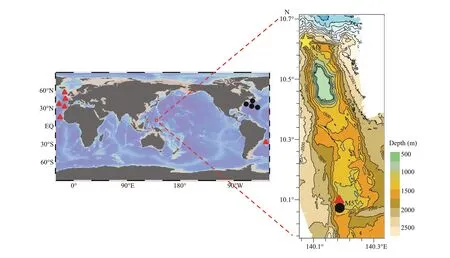
Fig.1 Geographic distribution of Umbellapathes parva sp.nov.(yellow star),Telopathes magna MacIsaac &Best,2013 (black dots),and Stauropathes punctata (Roule,1905) (red triangles)

Table 1 GenBank accession numbers for all specimens/species included in this study
Several fragments were taken from distal pinnules on upper part of corallum of each specimen for scanning electron microscopy (Horowitz et al.,2020).The larger tissues are carefully removed with forceps.The remaining smaller tissues were cleaned with commercial bleach for 1–2 min,and then transferred to 90% alcohol for 1 h (Wagner and Opresko,2015).To study the microscopic skeletal structure of spines,they were air-dried,fixed to carbon double adhesive tape,coated with golden and observed with scanning electron microscope.All measurements were taken on the preserved material,following Wagner et al.(2010).Terminology follows Opresko et al.(2014).
2.2 DNA extraction and sequencing
The nuclear rDNA internal transcribed spacer(ITS) region spanning partial 18S rDNA,ITS1,5.8S,ITS2,and partial 28S rDNA has been proved tosuccessfully evaluate the phylogenetic relationships and establish new taxa for black coral species (Lapian et al.,2007;Bo et al.,2009,2018;Wagner et al.,2010).Meanwhile,two frequently used markers,mitochondrialcox3-IGR-cox1(COI) andtrnW-IGRnad2(NAD2) were also selected for the phylogenetic analyses.
Genomic DNA was extracted from each specimen using the DNeasy Blood and Tissue Kit (Qiagen,Hilden,Germany) following the instructions.PCR amplifications for the ITS,COI,and NAD2 regions were conducted using primer pairs RA2 (5ʹ-GTCCCTGCCCTTTGTACACA-3ʹ) and ITS 2.2 (5ʹ-CCTGGTTAGTTTCTTTTCCTCCGC-3ʹ;Wörheide,1998),CO3 gen3360F (5ʹ-CTTTGTGGCAACTGGGTTTCATG-3ʹ) and CO1 gen4446R (5ʹ-GATAACATTGCATAAACCATCCCT-3ʹ;Thoma et al.,2009),and TRPantiF (5ʹ-GGAAGACCGTTAGCCTTC-3ʹ) and NAD2anti1040R (5ʹ-CCAAATAAGAATAAGCCTGAAG-3ʹ;Thoma et al.,2009),respectively.PCR reactions were performed using I-5TM2× High-Fidelity Master Mix DNA polymerase (TsingKe Biotech,Beijing,China).The amplification cycle conditions were as follow:denaturation at 98 °C for 2 min,followed by 32 cycles of denaturation at 98 °C for 20 s,annealing at 51–55 °C for 20 s,extension at 72 °C for 15 s,and a final extension step at 72 °C for 2 min.PCR purification and sequencing were performed by TsingKe Biological Technology(TsingKe Biotech,Beijing,China).
2.3 Genetic distance and phylogenetic analyses
The ITS,COI,and NAD2 sequences of Schizopathidae spp.and two Cladopathidae species as an out group were downloaded from GenBank (Table 1).The nucleotide sequences were aligned using MAFFT v.7 (Katoh and Standley,2013) with the G-INS-i algorithm.The nucleotide alignment was trimmed to equal length using BioEdit v7.0.5 (Hall,1999).Genetic distances of ITS1-5.8S-ITS2 between species/populations were calculated with MEGA 6.0 using Kimura 2-parameter model (Tamura et al.,2013).
Phylogenetic analyses were performed on the ITS,mitochondrial regions (COI-NAD2),and concatenated ITS,COI,and NAD2 (ITS-COI-NAD2) datasets.When conspecific sequences were identical,only one was chosen for analysis.The taxa included in the COI-NAD2 trees are fewer than the ITS and ITSCOI-NAD2 ones (20 vs.26 for both the two latter datasets;Table 1).The best-fit models,GTR+G for COI-NAD2,and GTR+I+G for ITS and ITS-COINAD2 were selected by SMS with the Akaike information criterion in PhyML-3.0 (see http://www.atgc-montpellier.fr/phyml/;Lefort et al.,2017) on the online ATGC bioinformatic platform.Maximum likelihood (ML) analysis was carried out using PhyML-3.0 (Guindon et al.,2010),with node support from a majority-rule consensus tree of 1 000 bootstrap replicates.Following Hillis and Bull (1993),the ML bootstraps <70%,70%–94%,and ≥95% were considered as low,moderate,and high,respectively.Bayesian inference (BI) analysis was performed using MrBayes v3.2.7a (Ronquist and Huelsenbeck,2003).Posterior probability was estimated based on 10 000 000 Monte Carlo Markov Chain (MCMC)generations (×4 chains) sampling every 1 000 generations (burn-in=25%).Convergence of the MCMC was assessed using Tracer 1.4.1 (Drummond and Rambaut,2007).Following Alfaro et al.(2003),the Bayesian posterior probabilities <0.95 and ≥0.95 were considered as low and high,respectively.
3 RESULT
3.1 Taxonomy
Class Anthozoa Ehrenberg,1831
Order Antipatharia Milne-Edwards &Haime,1857
Family Schizopathidae Brook,1889
Subfamily Parantipathinae Roule,1905
Genus Umbellapathes Opresko,2005
Type species:Umbellapathes helioanthes Opresko,2005
Umbellapathes parva sp.nov.(Figs.2 &3;Table 2)
Material examinedHolotype:MBM286412,station FX-Dive 226 (10°38ʹ08″N,140°04ʹ08″E),M8 seamount,depth 1 766 m,14 June 2019.Paratype:MBM286410,station FX-Dive 224 (10°37ʹ36″N,140°05ʹ25″E),M8 seamount,depth 1 488 m,12 June 2019;MBM286411,station FX-Dive 224(10°37ʹ38″N,140°05ʹ27″E),M8 seamount,depth 1 509 m,12 June 2019.
DiagnosisCorallum monopodial and pinnulate,up to three orders of branches arising from the primary pinnules of stem.Unpinnulated portion of stem long and slightly curved.Primary pinnules on branches and stem arranged in two lateral or anterolateral rows and in alternating pattern.Secondary pinnules arranged uniserially on front side of primary pinnules.Spines smooth,conical,rarely forked,with blunt or acute apex.Polypar spines 0.038–0.050-mm high and abpolypar spines 0.017–0.044-mm high.Spines in 3–5 rows from lateral view,with 2–5 spines per millimeter in each row.Polyps 1.8–3.4 mm in transverse diameter.
Description of holotypeColony was slightly pink in situ and became yellowish-brown after being preserved in alcohol.The corallum is about 31-cm high and 19-cm wide,with the basal attachment plate about 1.5 cm×2 cm (Fig.2i;Table 2).The unpinnulated stalk is about 26.5-cm long,3.5 mm×1.8 mm in diameter near the base,and 1 mm in diameter just below the first branch (Fig.2j).There are up to three orders of branches arising from the primary pinnules of stem.The primary pinnules on branch and stem arranged in two lateral or anterolateral rows and in alternating pattern.The stem pinnules develop into pinnulated branches and form discoidal crown(Fig.2l).The lengths of branches and pinnulated branches range from 5 cm to 17 cm.The stem is slightly curved and the pinnulated portion of stem grows upwards and then bent backwards.
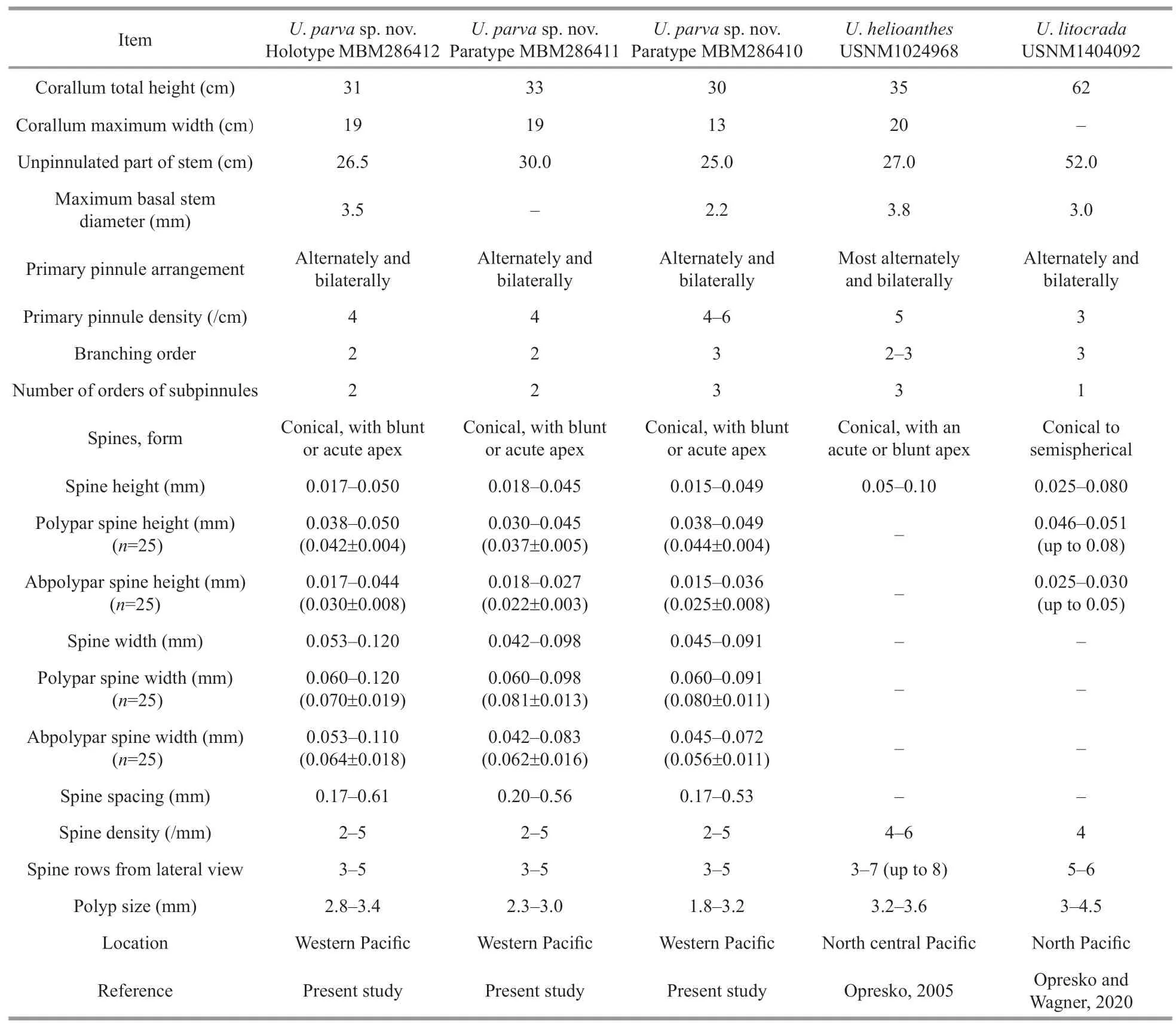
Table 2 Comparison of all known species of Umbellapathes
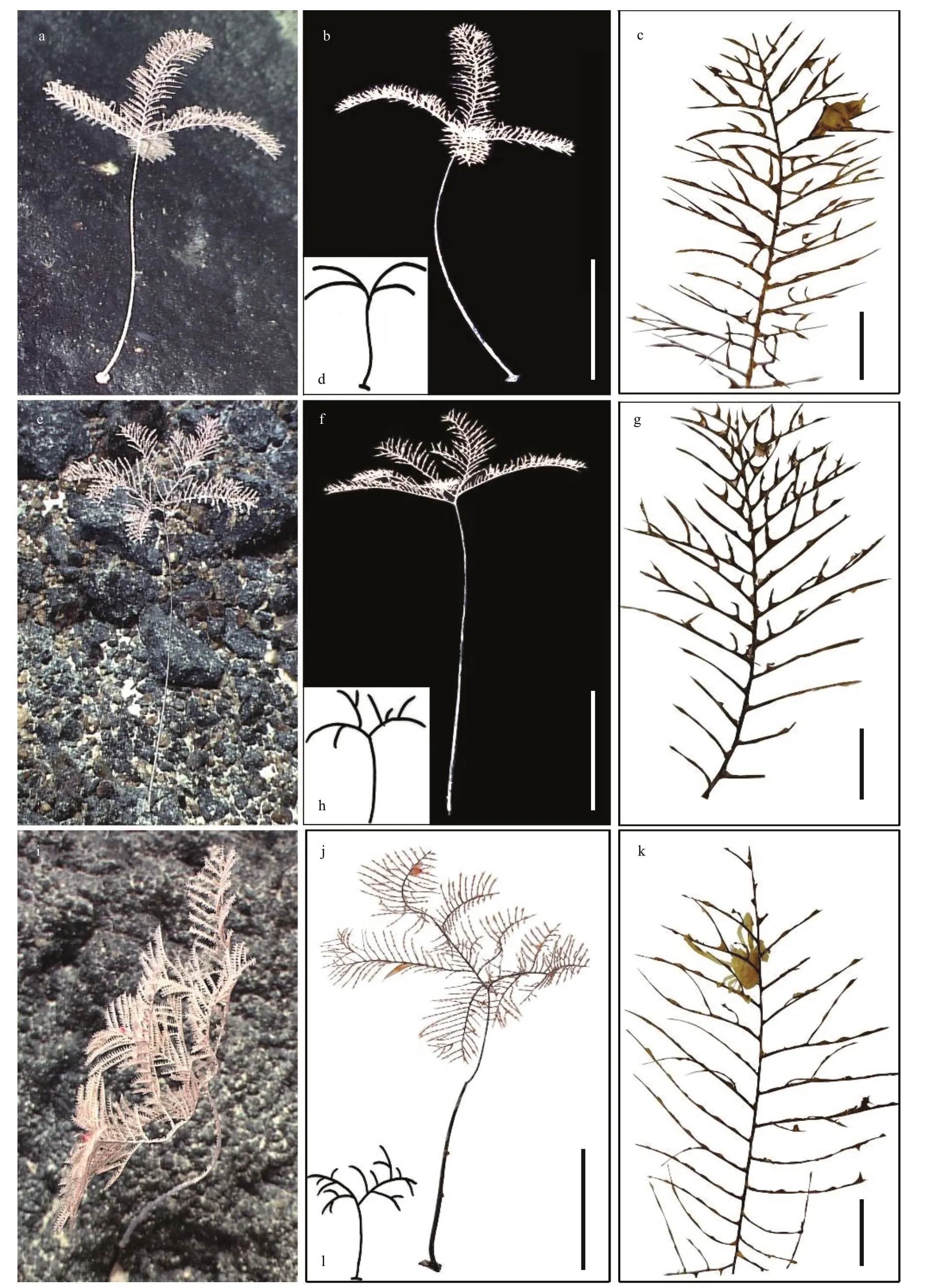
Fig.2 The external morphology of Umbellapathes parva sp.nov.
Primary pinnules on larger branches and pinnulated branches are arranged biserially and alternately(Fig.2k).They are spaced 5–7 mm on the same side of the axis,about 4 pinnules per centimeter for both sides.The length of primary pinnules ranges from 0.7 cm to 4 cm.The distal angle between primary pinnules and pinnulated branches ranges from 60° to 70°.The internal angle between the two anterolateral rows of primary pinnules is in the range of 110°–130°.
The subpinnules are arranged uniserially and inclined to the distal ends.There are 1–2 secondary pinnules on each primary pinnules,0.5–1.5 cm in length and spaced 5–8-mm apart along the pinnules(Fig.2k).The distal angle formed by the secondary pinnules and the primary pinnules ranges from 30° to 60°.
Spines on pinnules and branches are simple,smooth,rarely forked,with blunt or acute apex,subequal in size along the axis on the same side(Fig.3;Table 2).The polypar spines on the middle part of the pinnules are 0.038–0.050-mm(0.042 mm± 0.004 mm,n=25) high and 0.060–0.12-mm (0.070 mm± 0.019 mm,n=25) wide at the base,and the abpolypar spines are much smaller,0.017–0.044-mm (0.030 mm± 0.008 mm,n=25) high and 0.053–0.11-mm (0.064 mm± 0.018 mm,n=25)wide at the base (Fig.3).On the basal part of the pinnules,the polypar spines are 0.036–0.045-mm tall and the abpolypar spines are mostly 0.018–0.027-mm tall.Along the distal parts of the pinnules,the polypar spines are 0.03–0.045-mm tall,and the abpolypar spines are 0.023–0.038-mm tall.Spines are arranged in 3–5 longitudinal rows from the lateral view.Larger polypar spines are usually in 4 rows and smaller abpolypar spines in 3 rows,when viewed from transection.The distance between adjacent spines in each row is 0.17–0.61 mm,about 2–5 spines per millimeter in each row.
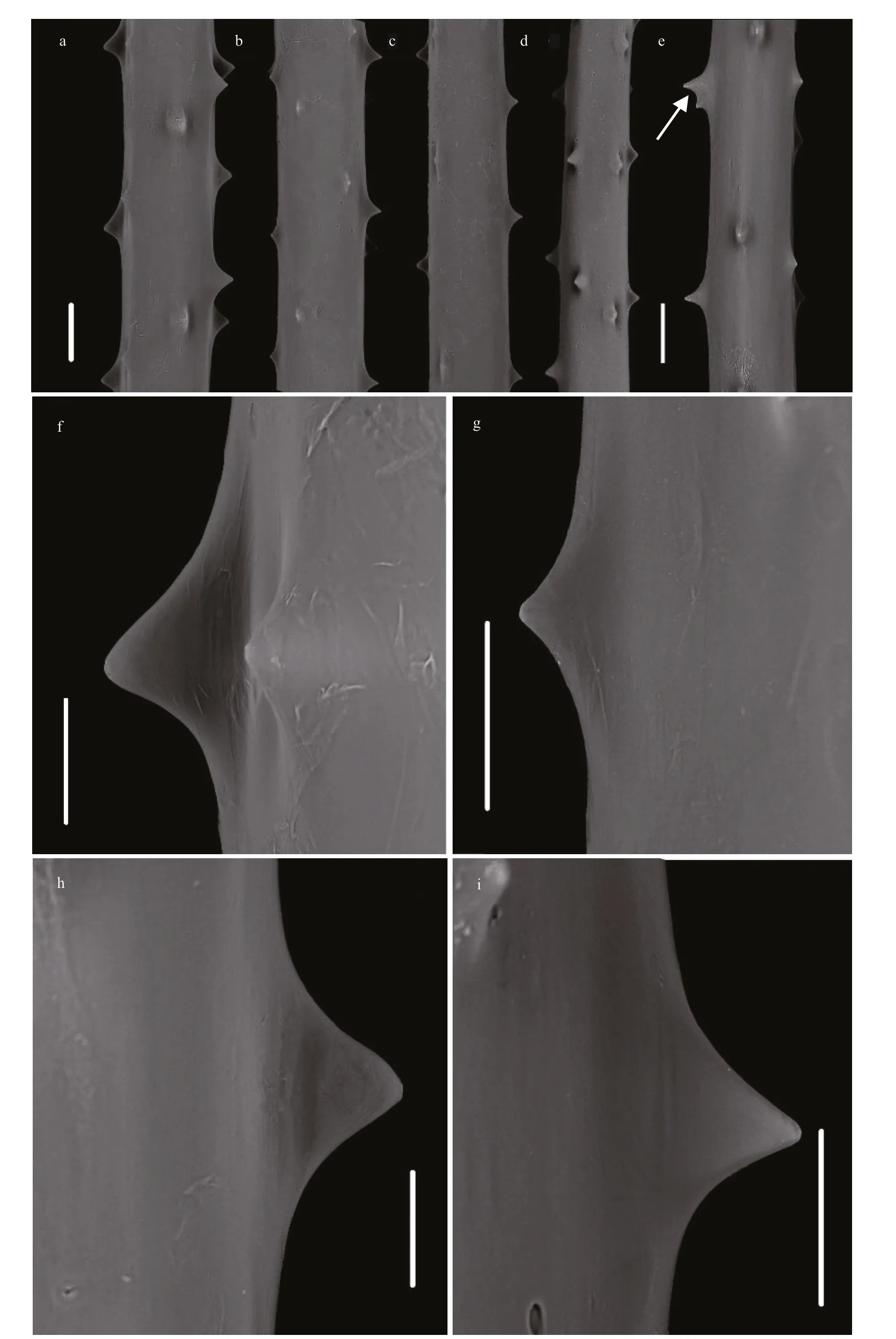
Fig.3 Spines of the holotype of Umbellapathes parva sp.nov.under Scanning Electron Microscope (SEM)
Polyps were not well preserved in ethanol-fixed specimens,about 2.8–3.4 mm in transverse diameter.The polyps in situ were arranged in a single row along each pinnule.
ParatypeThe two paratype specimens showed similar morphology as the holotype (Fig.2a–g).However,there are some minor differences.In the paratype MBM286410 and MBM286411,the arrangement of primary pinnules is closer and the degrees of pinnulation is relatively simple than in the holotype.Instead of forming discoidal crown,there are several elongated pinnulated branches growing upwards and then backwards in the paratype specimens.Additionally,the number of subpinnules in the holotype is lower than that in the paratype specimens and tertiary pinnules only occur in the paratype MBM286410 (Fig.2c;Table 2).These differences are minor and not constant.
Type localityA seamount (tentatively named as M8) located on the Caroline Ridge in the Western Pacific Ocean (10°38ʹ08″N,140°04ʹ08″E) with depth of 1 766 m.
EtymologyThe Latin adjectiveparvus(small)refers to the small spines of the species.
Distribution and habitatFound only from the M8 seamount with depth of 1 488–1 766 m in the tropical Western Pacific Ocean (Fig.1),where the species attached on rocky substrate.
RemarksConsidering the pinnulation degree and basal stem diameter,the three specimens ofU.parvasp.nov.showed different growth stages,from simple pinnulation colony (younger colony) to complex pinnulation colony (adult).The specimen MBM286410 is likely a younger colony with 4 pinnulated branches and narrow basal stem (Fig.2b &d),the specimen MBM286411 is likely in the intermediate growth stage with 8 pinnulated branches and narrow basal stem (Fig.2f &h),and the specimen MBM286412 is possible an adult with 16 pinnulated branches and wider basal stem (Fig.2j &l).The spines are composed of two types,and the polypar spines are much larger than the abpolypar spines.However,both the size of the polypar spines and that of the abpolypar spines showed little variation within and among the three specimens (Table 2),and thus they can be served as differing features.
Umbellapathesparvasp.nov.belongs to the genusUmbellapathescharacterized by a long unpinnulated stem and pinnulated branches developing from primary pinnules.Umbellapathescontains only two species,U.helioanthes,Opresko,2005 andU.litocradaOpresko &Wagner,2020.Both of them were discovered from North Pacific (Opresko,2005;Opresko et al.,2020).The new species is most similar toUmbellapatheshelioanthesOpresko,2005,particularly in the arrangement of subpinnules and size of polyps (Opresko,2005).Opresko (2005) did not give separate measurements of the polypar and abpolypar spines.Nonetheless,U.parvasp.nov.can be distinguished fromU.helioanthesby its much smaller spines (0.017–0.044-mm high in abpolypar spines and 0.038–0.050-mm high in polypar spines vs.0.05–0.1-mm high;Table 2).U.parvasp.nov.is easily distinguished fromU.litocradaOpresko &Wagner,2020 by the present of secondary pinnules(present vs.absent), the shape of spines (conical vs.conical to semispherical;Table 2).
Subfamily Schizopathinae Brook,1889
Genus Telopathes MacIsaac &Best,2013
Type species:Telopathes magna MacIsaac &Best,2013
Telopathes cf.magna MacIsaac &Best,2013(Figs.4 &5;Table 3)
TelopathesmagnaMacIsaac &Best,2013:237–258;figs.2–7.
Material examinedMBM286483,station FXDive 209 (10°04ʹ40″N,140°12ʹ13″E),M5 seamount,depth 1 016 m,27 May,2019;MBM286482,station FX-Dive 210 (10°04ʹ39″N,140°12ʹ07″E),M5 seamount,depth 937 m,28 May,2019;MBM286481,station FX-Dive 210 (10°04ʹ39″N,140°12ʹ07″E),M5 seamount,depth 945 m,28 May,2019;MBM286480,station FX-Dive 210 (10°04ʹ39″N,140°12ʹ07″E),M5 seamount,depth 944 m,28 May,2019.
DescriptionColony was brownish in situ and became dark brown after being preserved in alcohol.The monopodial corallum is about 24.8-cm high and 15.9-cm wide,and the unpinnulated section of lowermost stem is about 7.5-cm long (Fig.4a–b;Table 3).The basal attachment plate is 0.6 cm across,and the stem is about 2.1 mm in diameter near the basal attachment plate and 0.4 mm in diameter near the top of stem.The colony consists of 24 pairs of bilateral and subopposite pinnules.The length of pinnules ranges from 2 cm to 8.2 cm.Pinnules increase in length from the lowermost pairs of pinnules,reach maximum length at about the mid-pair,then decrease in length to the shortest at the top of colony.Pinnule pairs are spaced 8–12-mm apart (mostly 8 mm),with distance decreasing from the lowest pairs toward the apex of colony.In each pair,the pinnule on the right side (viewing the front of the corallum) is 1-mm higher than the pinnule on the left.The distal angle between the stem and pinnules ranges from 60° to 70°.The interior angle between subopposite pairs is in the range of 100°–150°.

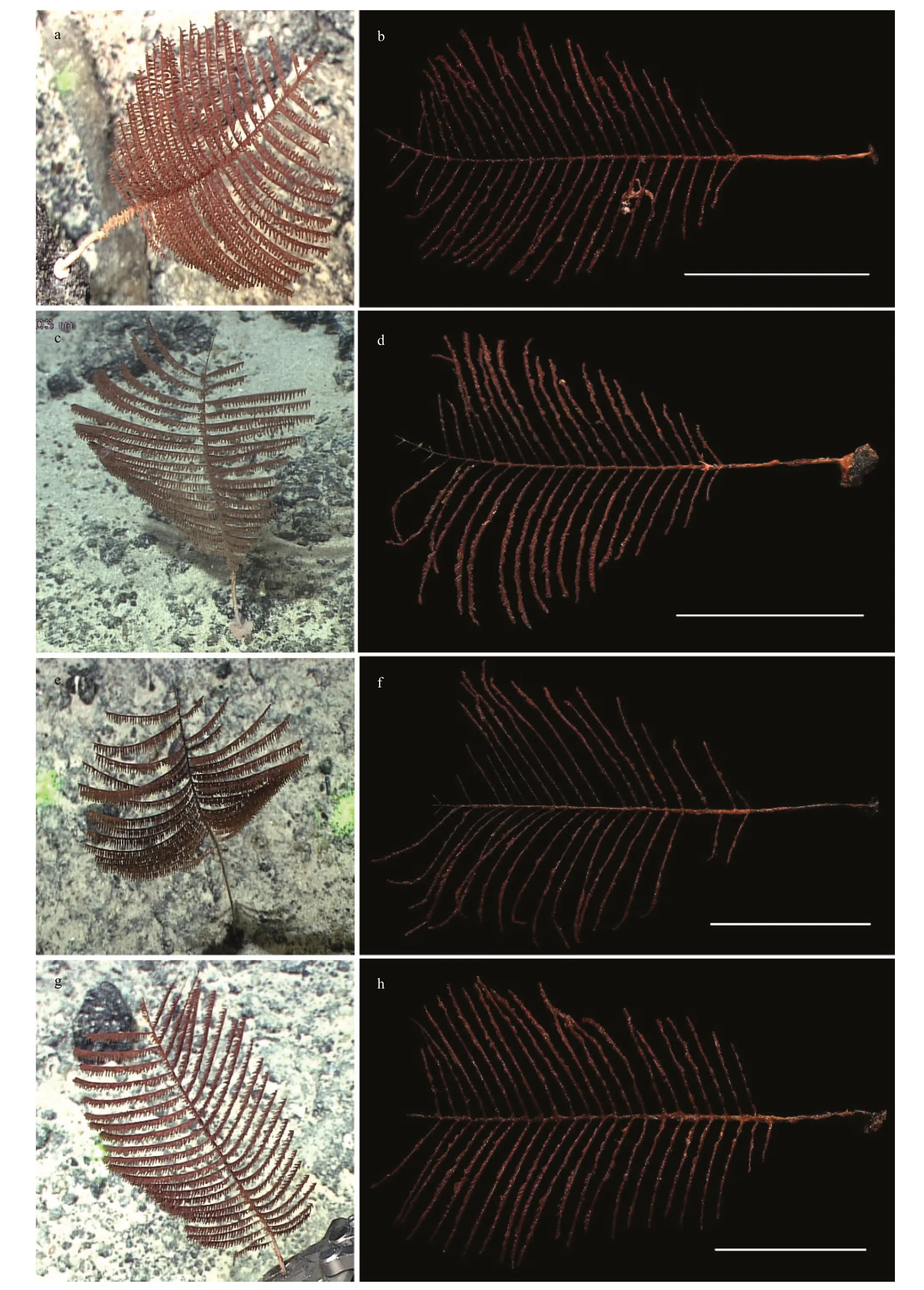
Fig.4 The external morphology of Telopathes cf.magna MacIsaac &Best,2013
Spines on pinnules are simple,smooth,conical and nearly equal-sized on the same side of axis (Fig.5a–e).The polypar spines are 0.038–0.053-mm(0.046 mm± 0.004 mm,n=35) high and 0.041–0.078-mm (0.063 mm± 0.010 mm,n=35) wide at the base,and the abpolypar spines are 0.030–0.038-mm(0.036 mm± 0.002 mm,n=35)-mm high and 0.030–0.061-mm (0.047 mm± 0.010 mm,n=35)-mm wide at the base.Spines are arranged in 5–8 rows from the lateral view.Larger polypar spines are usually in 6 rows and smaller abpolypar spines in 4 rows,when viewed from transection.Spines are spaced 0.11–0.30-mm apart,about 5–7 spines per mm in each row.Polyps are not well preserved in ethanolfixed specimens,about 4–6 mm in transverse diameter(Table 3).
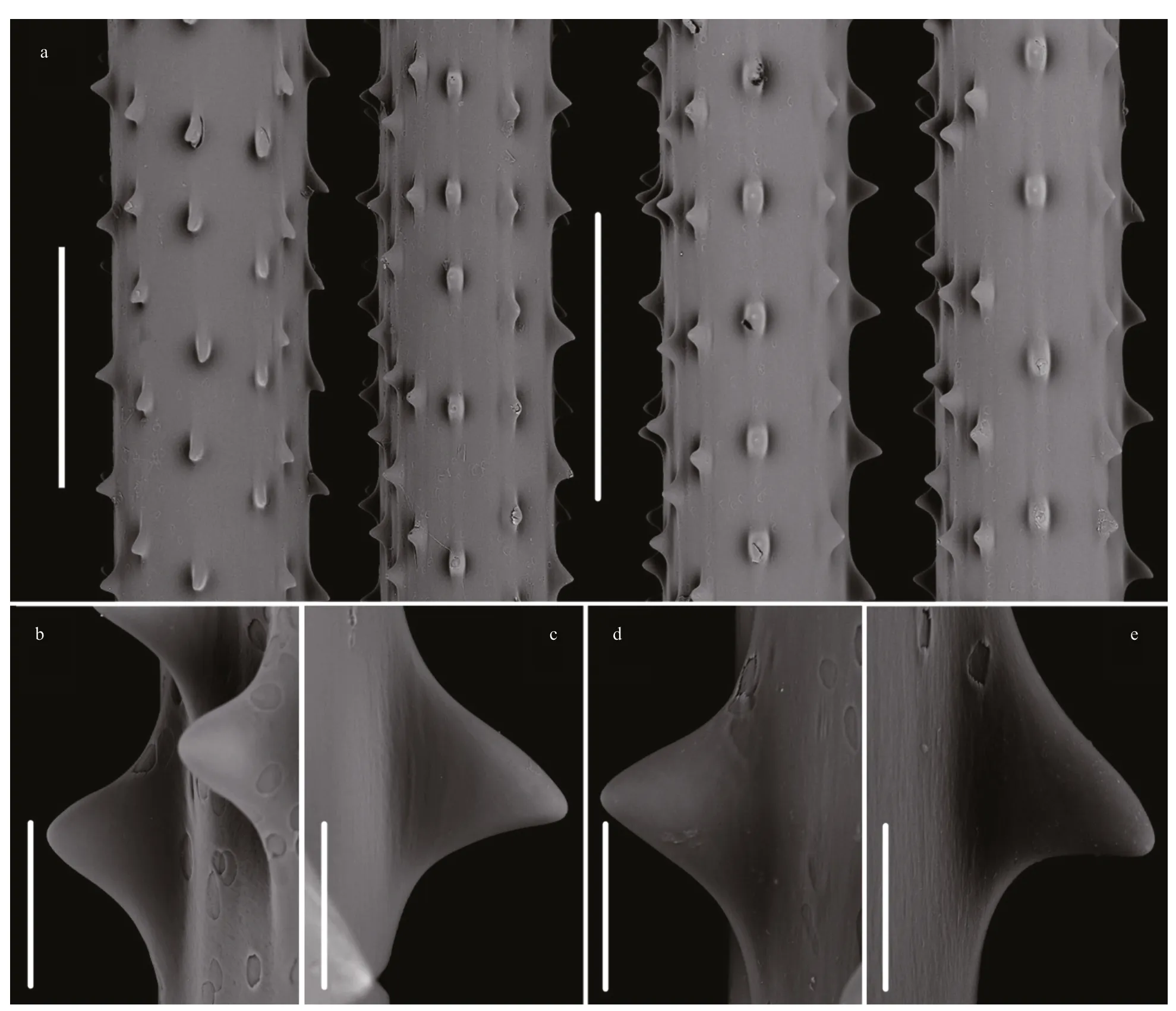
Fig.5 Spines of Telopathes cf.magna MacIsaac &Best,2013 (MBM286483) under SEM
Distribution and habitatThe species was first found from the Northwestern Atlantic,i.e.,on the continental slope off Nova Scotia,New England Seamounts,and Corner Rise Seamounts with depth of 1 073–1 983 m (MacIsaac et al.,2013;Fig.1).In the tropical Western Pacific,it was found on rocky substrate of the M5 seamount with depth of 937–1 016 m.The in-situ water temperatures were 5.0–5.1 °C and the salinity approximately 36.0–36.7.
RemarksThe four Pacific specimens match with the holotype ofT.magnain having the relatively long,simple,bilateral pinnules and simple,conical spines and large polyps.The main difference is that our specimens have a smaller colony size and lack of branching (MacIsaac et al.,2013).Other minor differences include the arrangement of pinnules(subopposite to alternate vs.only subopposite) and the color of living colony (brownish vs.bright orange),and the spine density is slightly more crowded in the specimen MBM286481 than that in the holotype (4–10 vs.2–6 per millimeter).However,MacIsaac et al.(2013) reported that the small/young colonies ofT.magnamight lack branching.The overall corallum morphology of the four specimens is more similar to that of the juvenile colony (see Fig.6b in MacIsaac et al.(2013)) rather than the adult holotype ofT.magna.Furthermore,there is no or only one-nucleotide variation of ITS-5.8S-ITS2 between the present specimens and the previously published ones (see the molecular result),and there is no genetic variation of NAD2 between them.The four specimens likely represent certain juvenile/youngcolony stages ofT.magna.Nevertheless,considering that all the reported samples were discovered in the Northwestern Atlantic,we identified the four Pacific specimens asT.cf.magna.More specimens,especially the adult ones from the Pacific are needed to confirm their conspecific assignment or reject it.
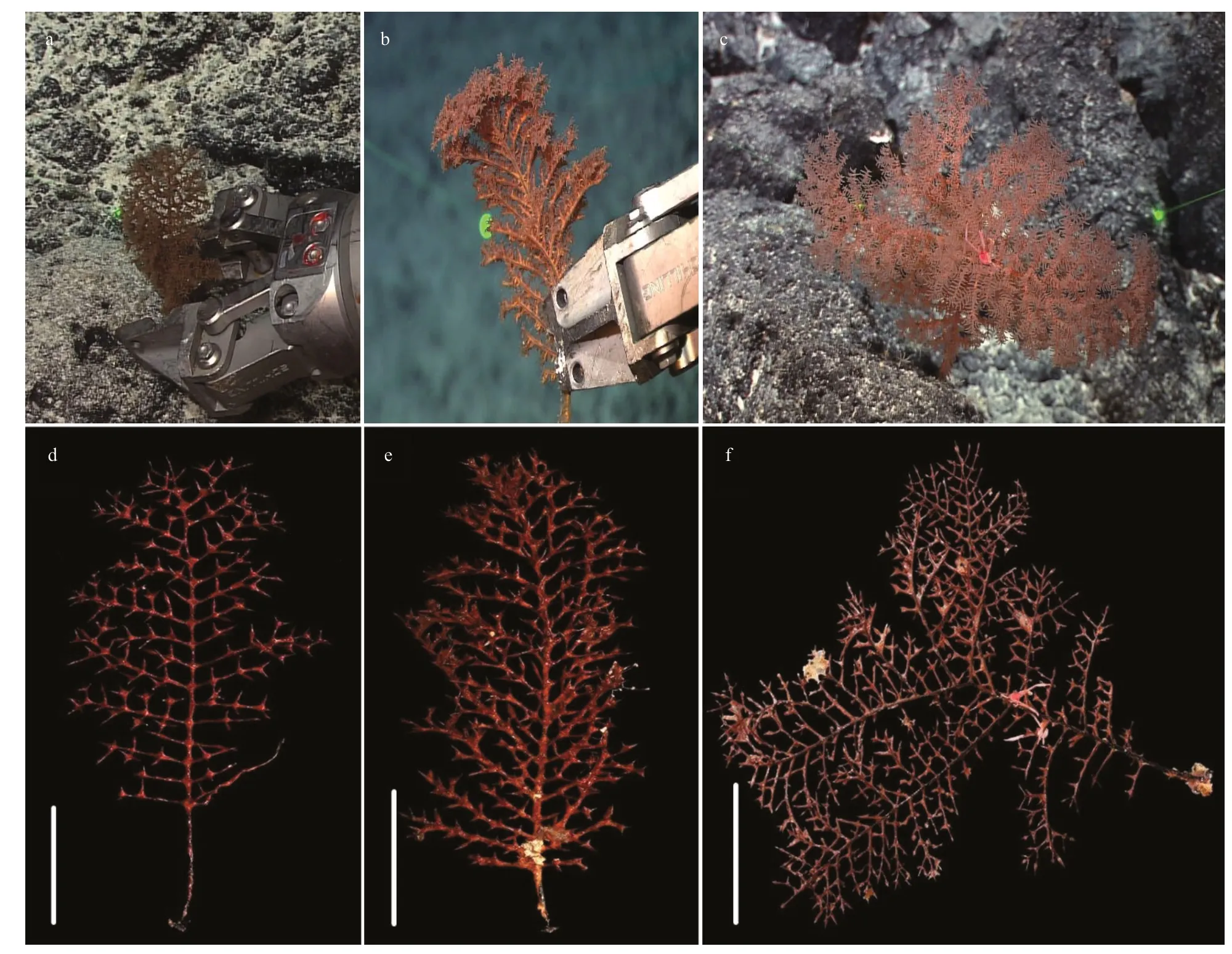
Fig.6 The external morphology of Stauropathes cf.punctata (Roule,1905)
Subfamily Schizopathinae Roule,1905
Genus Stauropathes Opresko,2002
Type species: Stauropathes staurocrada Opresko,2002
Stauropathes cf.punctata (Roule,1905) (Figs.6,7;Table 4)
(?) Tylopathes hirta-Roule 1902:81–82;pl.4:1.
Tylopathes?punctataRoule,1905:26,28,35,81,93,95.Fig.1;Opresko,2002:417,420.
AntipathespunctataSilberfeld 1909:8;Land &Opresko,2001:109;Grasshoff,1985b:303,306;Tyler &Zibrowius,1992:217.
StauropathespunctataOpresko,2002:417,420;Molodtsova,2006:148;Molodtsova,2014:6;Lima et al.,2019:41.
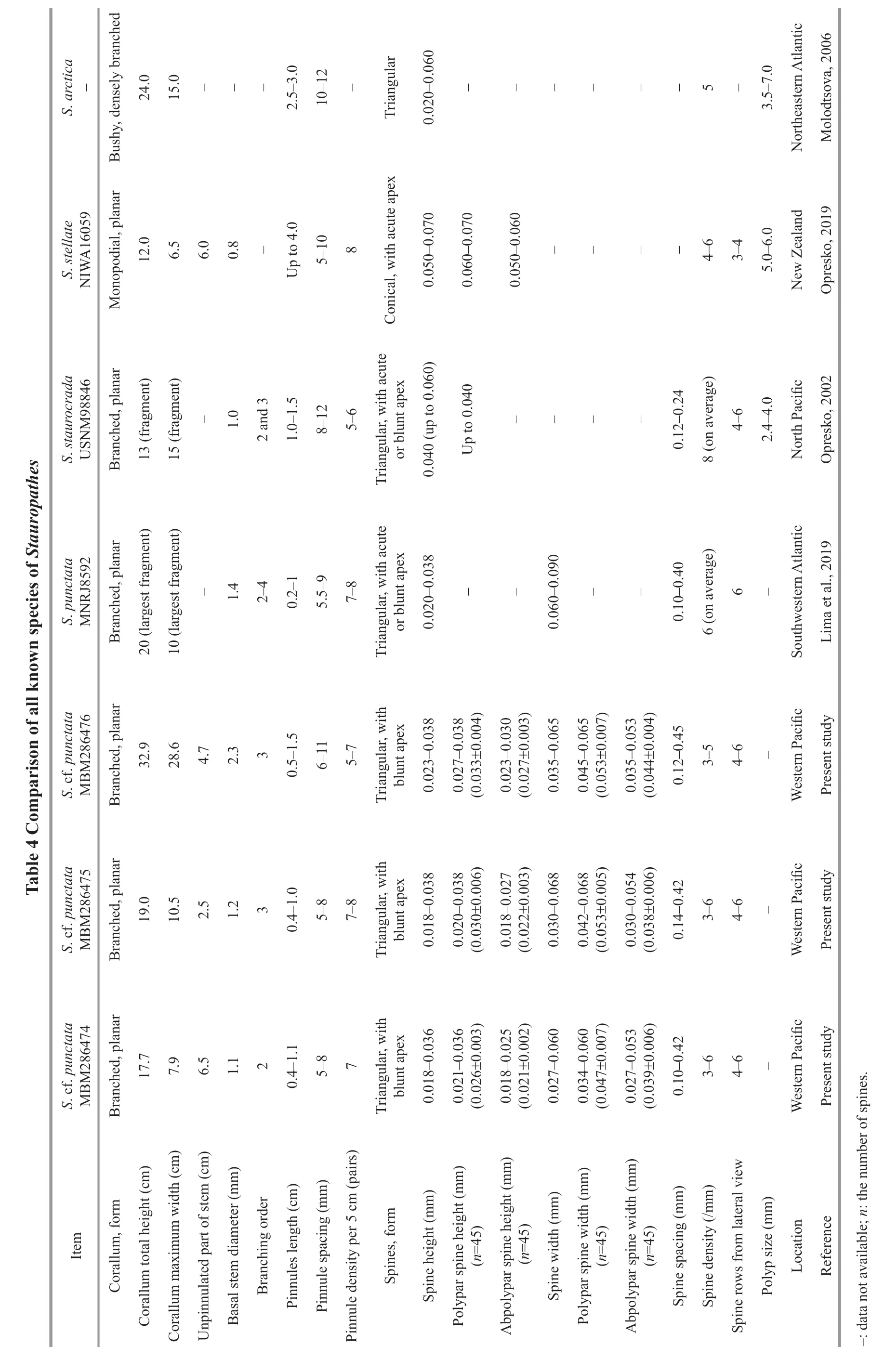
Material examinedMBM286474,station FXDive 209 (10°04ʹ42″N,140°12ʹ11″E),M5 seamount,depth 1 087 m,27 May,2019;MBM286475,station FX-Dive 210 (10°04ʹ39″N,140°12ʹ07″E),M5 seamount,depth 942 m,28 May,2019;MBM286476,station FX-Dive 212 (10°03ʹ19″N,140°10ʹ45″E),M5 seamount,depth 1 353 m,30 May,2019.
DescriptionColony reddish brown in situ and became brown after being preserved in alcohol.The corallum is branched to third order and generally in a single plane,about 32.9-cm high and 28.6-cm wide(Fig.6c &f;Table 4).The stem extends to the top of corallum and the unpinnulated section of stem is about 4.7-cm long.The basal attachment plate is about 1.7 cm in diameter and the stem about 2.3 mm near the basal attachment plate.The pinnulated part of stem consists of 12 pairs of subopposite pinnules and branches,which are 2–19-cm long and 8–12-mm spaced along the stem.The pinnules are 0.5–1.5-cm long and 6–11-mm spaced on the branches.The pinnules spacing generally decreases from the lowest pairs towards the apex of branches.Distal angle formed by stem and pinnules is in the range of 65°–90°.Internal angle between the subopposite pairs ranges from 100° to 140°.
Spines on pinnules are simple,smooth,conical,and nearly equal-sized on the same side of axis(Fig.7).The polypar spines are 0.027–0.038-mm(0.033 mm± 0.004 mm,n=45) in height and 0.045–0.065-mm (0.053 mm± 0.007 mm,n=45) in width,and the abpolypar spines are 0.023–0.030-mm(0.027 mm± 0.003 mm,n=45) in height and 0.035–0.053-mm (0.044 mm± 0.04 mm,n=45) in width.Spines are arranged in 4–6 rows from the lateral view (Fig.7).Polypar spines are usually in 6 rows and abpolypar spines in 4 rows,when viewed from transection.There are 3–5 spines per mm in each row,where they are 0.12–0.45-mm spaced.Polyps are not well preserved in ethanol-fixed specimens.

Fig.7 Spines on the pinnules of Stauropathes cf.punctata (Roule,1905) under SEM
Distribution and habitatThe speciesStauropathespunctatawas found from Santa Cruz das Flores Island,the Azores,Portugal,and Cabo Verde Archipelago in the Northeastern Atlantic with depth of 1 300 m (Roule,1905;Molodtsova,2006) and from the Rio Grande Rise in the Southwestern Atlantic with depth of 1 600 m (Lima et al.,2019;Fig.1).In the tropical Western Pacific,the species occurred on the rocky substrate of the M5 seamount,where the depths were 942–1 353 m,water temperatures about 3.9–5.0 °C and salinity approximately 36.5–36.7.
RemarksTo date,there are four species in the genusStauropathes:S.arctica(Lütken,1872),S.punctata(Roule,1905),S.staurocradaOpresko,2002,andS.stellateOpresko,2019.The three specimens from the Caroline seamounts are highly similar to the description ofS.punctataby Lima et al.(2019) as well as the incomplete original description by Roule (1905).All of them have monopodial and planar corallum with two rows pinnules arranged in subopposite pairs. Moreover,the ITS,COI,and NAD2 sequences of the three specimens are identical.Considering all the records of the species were discovered from Atlantic,we identified the three Pacific specimens asS.cf.punctata.
Opresko (2002) separatedS.punctatafromS.staurocradasolely by the pinnule spacing (6–8 mm vs.8–12 mm).Considering the corallum size,branching degree and basal stem diameter,the specimen MBM286476 with large and complex branching colony is likely an adult colony,while the specimens MBM286474 and MBM286475 with small and sparsely branched colonies are younger colonies (Table 3).The spine size is nearly identical between the younger colony and adult colony and can be used for species identification.By contrast,the pinnule spacing is highly variable (5–8-mm apart in the younger colony vs.6–11-mm apart in the adult colony),and thus we consider it as conspecific variation.The data show that the ranges of the pinnule spacing are highly variable in conspecific specimens and overlap betweenS.cf.punctataandS.staurocrada(5–11 mm vs.8–12 mm),indicating that pinnule spacing may be not a good feature to separateStauropathesspecies.In addition,Stauropathescf.punctatadiffers fromS.arcticaandS.stellateby the corallum mainly in a single plane and the smaller spines (Table 4).
3.2 Genetic distance and phylogenetic analyses
The ITS,COI,and NAD2 sequences of the three species were deposited in GenBank (Table 1).The alignment datasets of ITS1-5.8S-ITS2,ITS(comprising partial 18S and 28S rDNA),COI-NAD2,and ITS-COI-NAD2 comprised 653,796,1 379,and 2 175 nucleotide positions,respectively.The intraspecific distances of ITS1-5.8S-ITS2 were calculated based onTelopathesmagna,Telopathescf.magna,andUmbellapathesparvasp.nov.populations/specimens,and the distances were in range of 0−0.17% (Supplementary Table S1).The distances betweenTelopathesmagnaandTelopathescf.magnawere in range of 0−0.17%,and those betweenUmbellapathesparvasp.nov.and the closely related speciesAlternatipathesbipinnatawere in range of 1.72%−1.89% (Supplementary Table S1).
The phylogenetic reconstruction of ITS showed nearly identical results as that of the concatenated ITS-COI-NAD2,but with lower resolution,and the COI-NAD2 trees (Supplementary Fig.S1) were also highly similar to those of ITS-COI-NAD2.Hence,only the ITS-COI-NAD2 results are showed here.The ML and BI analyses yielded an identical topology,and thus only the BI tree with both support values are shown (Fig.8).All the Schizopathidae species were separated into two main clades corresponding well to the two subfamilies Schizopathinae and Parantipathinae with full node support.The species of Schizopathinae were separated into three sister subclades:(1) all theTelopathesmagnapopulations formed a monophyletic subclade with full node support;(2)Stauropathespunctata,S.cf.punctata,Bathypathessp.MG023167,andTelopathessp.MT318882 formed a subclade;(3)StauropathesarcticaMT318879 nested into a subclade includingBathypathespatulaandBathypathessp.1−3.Within Parantipathinae,Umbellapathesparvasp.nov.clustered withAlternatipathesbipinnatawith low support (ML 74%,BI 0.90),followed by theParantipathessubclade (includingSibopathescf.macrospina),and the groupDendrobathypathessp.andLillipatheswingibranched basally with high support (ML 97%;BI 1.00).
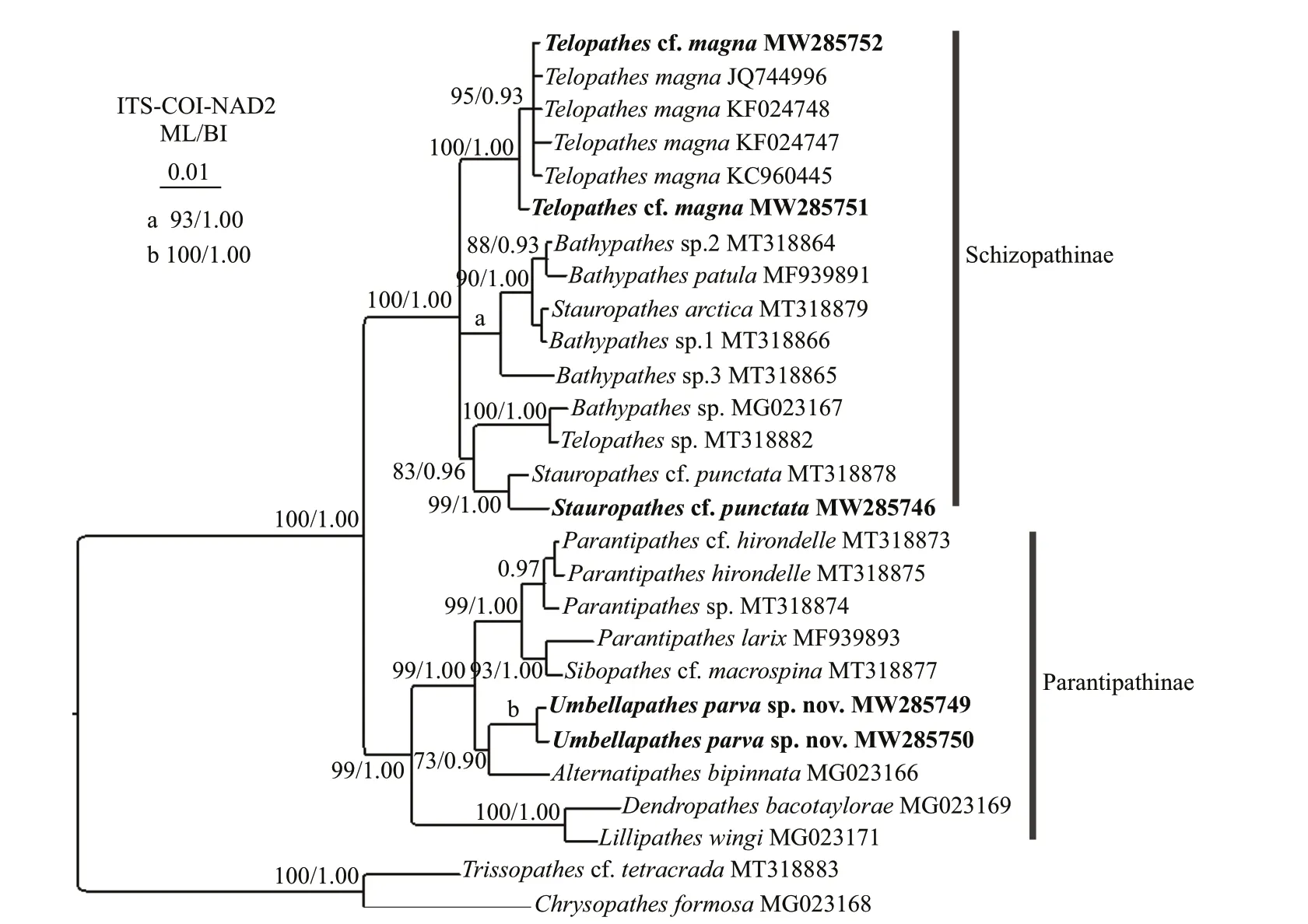
Fig.8 Maximum likelihood (ML) tree inferred from the ITS-COI-NAD2 sequences of Schizopathidae and Cladopathidae.
4 DISCUSSION
In the present study,we added the sequences ofTelopathescf.magnaandUmbellapathesparvasp.nov.and the congeneric sequences ofStauropathesfor the phylogenetic analyses.Within the Parantipathinae clade,Umbellapathesparvasp.nov.formed a sister subclade withAlternatipathesbipinnata(Fig.8),which is consistent with their morphological data.Umbellapathesparvasp.nov.is similar toA.bipinnatain growth form of colony,and both of them have a long unpinnulated stalk and lowermost pinnules developing into pinnulated branches (Opresko,2005).There is even no or only one-nucleotide variation of COI between them.However,Umbellapathesparvasp.nov.is easily distinguished from the latter by the present of secondary pinnules (vs.absent).Furthermore,the relatively far distances (1.72%−1.89%) of ITS1-5.8SITS2 supported their separating.In addition,Umbellapathesparvasp.nov.is most similar toU.helioanthesexcept for the spine characteristics and molecular evidence would be useful to support identifying it as a new species.However,no sequence ofU.helioanthesandU.litocradais available in the GenBank.Future research including the congener sequences are needed to confirm the establishment of the new species.
All the trees showedTelopathes,Stauropathes,andBathypatheshad close relationships (Fig.8;Supplementary Fig.S1).There was no genetic variation of ITS1-5.8S-ITS2 betweenStauropathesarcticaMT318879 andBathypathessp.1 MT318866,and only four of 17 700 nucleotide differences were found between their mitogenomes,suggesting they belong to the same genus (Supplementary Table S1).Similarly,the distances betweenTelopathessp.MT318882 andBathypathessp.MG023167 was 0.17%,indicating they may also belong to the same genus.Due to no available morphological information(not shown in the associated reference Barrett et al.,2020),these sequences need further verification.Excluding the uncertain sequences,the monophylies ofTelopathes,Stauropathes,andBathypathesare not rejected.Nonetheless,sequence data from more classified species of these genera are needed to confirm their monophylies.
5 CONCLUSION
We report three black corals,Umbellapathesparvasp.nov.,Telopathescf.magna,andStauropathescf.punctata,from seamounts in the tropical Western Pacific.The present phylogenetic analyses indicate thatTelopathes,Stauropathes,andBathypatheshave close relationships,andUmbellapathesformed a sister clade withAlternatipathes.
6 DATA AVAILABILITY STATEMENT
The specimens described in this study are available at the MBMCAS at IOCAS,Qingdao,China.Voucher IDs:Umbellapathesparvasp.nov.:MBM286410,MBM286411,MBM 286412;Telopathescf.magna:MBM286480,MBM286481,MBM286482,MBM 286483;Stauropathescf.punctata:MBM286474,MBM286475,MBM286476.The ITS sequences that support the findings of this study have been deposited in NCBI GenBank with the accession codes MW285749,MW285750 (Umbellapathesparvasp.nov.),MW285751,MW285752 (Telopathescf.magna),MW285746,MW285748,MW285747(Stauropathescf.punctata).The COI sequences that support the findings of this study have been deposited in NCBI GenBank with the accession codes MW285726,MW285727,MW285728(Umbellapathesparvasp.nov.),MW285729,MW285730,MW285731,MW285732 (Telopathescf.magna),MW285733,MW285734,MW285735(Stauropathescf.punctata).The NAD2 sequences that support the findings of this study have been deposited in NCBI GenBank with the accession codes MW285743,MW285744,MW285745(Umbellapathesparvasp.nov.),MW285739,MW285740,MW285741,MW285742 (Telopathescf.magna),MW285736,MW285737,MW285738(Stauropathescf.punctata).
7 ACKNOWLEDGMENT
We thank the assistance of the crew members of R/VKexueand ROVFaxianfor sample collection.Special thanks to Mr.Shaoqing WANG in IOCAS for photographing on board.
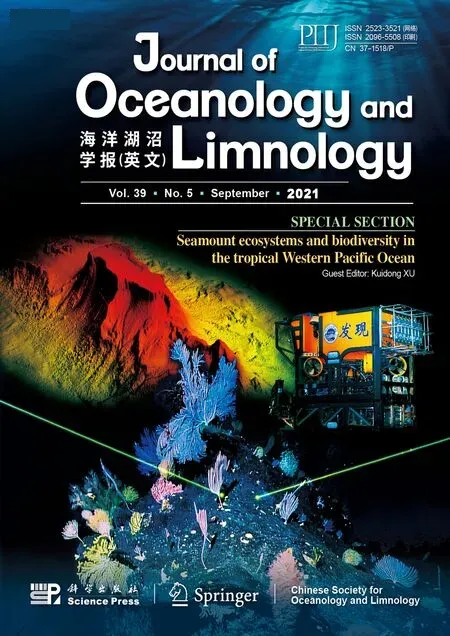 Journal of Oceanology and Limnology2021年5期
Journal of Oceanology and Limnology2021年5期
- Journal of Oceanology and Limnology的其它文章
- Screening of stable internal reference genes by quantitative real-time PCR in humpback grouper Cromileptes altivelis*
- Morphology and multifractal features of a guyot in specific topographic vicinity in the Caroline Ridge,West Pacific*
- Geochemical characteristics and geological implication of ferromanganese crust from CM6 Seamount of the Caroline Ridge in the Western Pacific*
- Deep-sea coral evidence for dissolved mercury evolution in the deep North Pacific Ocean over the last 700 years*
- Physical oceanography of the Caroline M4 seamount in the tropical Western Pacific Ocean in summer 2017*
- Characteristics and biogeochemical effects of oxygen minimum zones in typical seamount areas,Tropical Western Pacific*
